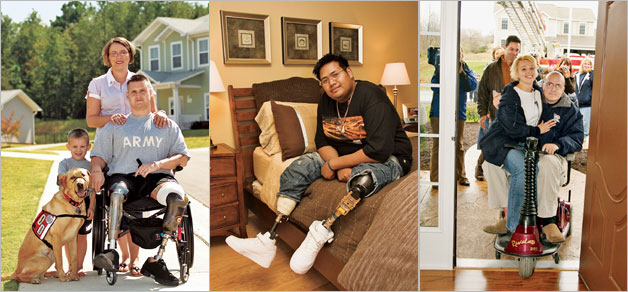sierraclub.org - sierra magazine - january/february 2009 - bulletin


Bulletin | News for Members
By Della Watson

Specially adapted, energy-efficient homes help put injured veterans--including Sergeants Darryl Wallace (far left), Pisey Tan, and Jeffrey Guerin--and their families at ease.
For builder John Gonsalves, it all started with news footage of Iraq soldiers reliving their experiences. "I remember watching the intensity in their eyes," he says. "It was the first time I saw any news reported by the people there." When he heard the veterans detail their horrific injuries, Gonsalves felt compelled to help. He searched online for an organization where he could apply his trade to provide homes for returning troops. No such program existed, so in 2004 Gonsalves created the nonprofit Homes for Our Troops to build specially adapted houses for disabled soldiers at no cost to the vets.
Last summer The Sierra Club Foundation donated $1 million to help the group build green. "American military families have faced incredibly challenging times over the past seven years," says Peter Martin, the foundation's executive director. "Now, with Homes for Our Troops, we are enabling veterans to return to a healthier living environment." In addition to roll-in showers, keyless doors, and easy-access cabinets, the new Energy Star-certified houses will incorporate efficient appliances, extra insulation, and solar panels or geothermal heating systems, ensuring lower power bills.
Besides the benefit to veterans, each project also educates the public. "These are very high-profile jobs," says Gonsalves. "With the house we just turned over, more than 60 companies were involved; we also had more than 400 volunteers from the community." Martin believes the green building practices will "rub off on others in the industry."
With almost 30 homes completed and more than 20 others in progress, the nonprofit is gearing up to meet the growing need. But Gonsalves hopes the demand for his houses will drop. "Wouldn't it be great if we went out of business because we had no customers?"
ON THE WEB Learn about a green dwelling built by Homes for Our Troops at homesforourtroops.org (click "Homes," then select the one in Golden, Colorado).
Honors Club
 Upholding NASA's pioneering reputation, top climate scientist James E. Hansen has been studying the causes of global warming and pushing for government action since the 1980s. To recognize Hansen's efforts--namely, his calls for 80 percent reductions in carbon dioxide emissions by 2050, a cornerstone of the Sierra Club's Climate Recovery Campaign--last fall the Club presented him with its highest honor, the John Muir Award.
Upholding NASA's pioneering reputation, top climate scientist James E. Hansen has been studying the causes of global warming and pushing for government action since the 1980s. To recognize Hansen's efforts--namely, his calls for 80 percent reductions in carbon dioxide emissions by 2050, a cornerstone of the Sierra Club's Climate Recovery Campaign--last fall the Club presented him with its highest honor, the John Muir Award.
At its September 20, 2008, banquet in San Francisco, the Club also recognized politicians, broadcasters, and activists. Washington senator Maria Cantwell (D) won the Edgar Wayburn Award for championing green issues and holding corporate polluters like Asarco responsible for their toxic cleanups. British naturalist Sir David Attenborough received the EarthCare Award for his decades-long career as a documentary producer, including narrating the 2006 BBC series Planet Earth. And Becky Gillette, director of the Club's National Formaldehyde Campaign, took home a Special Achievement Award for helping expose contamination in trailers provided by the Federal Emergency Management Agency to Hurricane Katrina victims.
The other winners were Steven Kazlowski (Ansel Adams Award for conservation photography); Boston Globe environmental reporter Beth Daley (David R. Brower Award); the Club's Big Bear Group (Denny and Ida Wilcher Award for fundraising and membership development); Andreas Marek and Craig Wolfe (Electronic Communications Award); Joan Saxe (Environmental Alliance Award for cofounding Maine Partners for Cool Communities); Andrew Nazdin, Carlos Rymer, and Erica Stout (Joseph Barbosa Earth Fund Award for under-30 Club members); Elizabeth Armon Neat (Madelyn Pyeatt Award for working with youths); Lehman Holder (Oliver Kehrlein Award for service to Sierra Club Outings); Fred Heutte (Raymond J. Sherwin Award for international volunteerism); Jim Dougherty and the Club's Puerto Rico Chapter (Special Achievement Award); David Blouin, Ann Harris, and Tyla Matteson (Special Service Award); Lane Boldman and Connie Wilbert (Susan E. Miller Award for contributions to Club chapters); Cal and Louise French (William E. Colby Award for administration); and Robert Ukeiley (William O. Douglas Award for representing the Club in Clean Air Act lawsuits).
ON THE WEB Read more about the winners, or nominate candidates for 2009, at sierraclub.org/awards.
Remembering a Hero
The Sierra Club lost a wilderness champion when former U.S. representative John Seiberling (D), winner of the Club's 1988 John Muir Award, passed away in Copley, Ohio, last August. He was 89. Seiberling fought to establish Ohio's Cuyahoga Valley National Recreation Area, now a national park, and helped pass the Alaska National Interest Lands Conservation Act, which protected more than 100 million acres. An attorney, Seiberling joined the Club's Ohio Chapter before running for Congress in 1970; he served in the House for 16 years. —Karina Kinik
Get Involved
To take action on the Sierra Club's top issues and find out how to contact your elected officials, visit sierraclub.org/takeaction. For the latest on Club campaigns and how you can help, sign up for our biweekly e-newsletter, the Sierra Club Insider, and other Club e-mails at sierraclub.org/email. Or check out our Action Center on Facebook (tinyurl.com/4mnjyx) for more online tools.
UTAH: Worth Its Salt
What do American avocets and Salt Lake City commuters have in common? Thanks to Sierra Club efforts, a new transit corridor that benefits migrating birds and people. Last September's opening of the Legacy Parkway and Nature Preserve near the Great Salt Lake capped off the Club's 11-year campaign to nix a proposed six-lane freeway through federally protected wetlands habitat, used by 7 million shorebirds and 3 million ducks each year. Partnering with groups like Utahns for Better Transportation, the Club helped convince the Utah Department of Transportation to redesign the project as a scenic four-lane thoroughfare, expand the mass-transit rail system, preserve 2,225 acres of wetlands, and include biking and hiking trails instead of big-box developments along the road. "Now we have a balanced transportation system that emphasizes quality of life," says Sierra Club organizer Marc Heileson. "We're building for people, not just cars." —Tom Valtin
MISSISSIPPI: Trump the Pump
Talk about murky logic: The U.S. Army Corps of Engineers wanted to build a $220 million water pump in the Mississippi Delta to drain wetlands for flood control, even though the marshes provide natural flood protection. Last fall the EPA vetoed the 67-year-old Yazoo Pumps proposal after receiving some 46,000 public comments opposing it. The Sierra Club's Mississippi Chapter and its allies fought the project for 20 years and led the drive to generate public input. Yazoo would've been one of the world's largest hydraulic pumps, threatening up to 200,000 acres of wetlands. The chapter's Louie Miller says the plan was designed to profit subsidized agribusiness by creating more cropland. Now it's time, he says, to "start looking for investment that directly benefits the community." —Hannah Buoye
WEST VIRGINIA: Turbines Versus TNT
Activists in Raleigh County, West Virginia, are blasting Massey Energy's plans to blow up some 6,000 acres of Coal River Mountain. The Sierra Club, Coal River Wind, Coal River Mountain Watch, and others champion an alternative: a 440-megawatt wind farm. The peak is one of the few in the area not damaged by mountaintop-removal coal mining, an especially destructive form of surface mining that clogs surrounding watersheds and devastates local ecosystems. The groups maintain that the wind project would produce more long-term energy, jobs, and revenue. "Three million pounds of explosives are detonated every day in West Virginia," says Jim Sconyers, chair of the state Club chapter. "It's an abhorrent environmental disaster." Learn more at coalriverwind.org. —Mario Jose Aguilar
Photo courtesy of Homes for Our Troops; used with permission.
Illustration by Debbie Drechsler; used with permission.